Charles E W Bean, Diaries, AWM38 3DRL 606/227/1 - Folder - Part 12
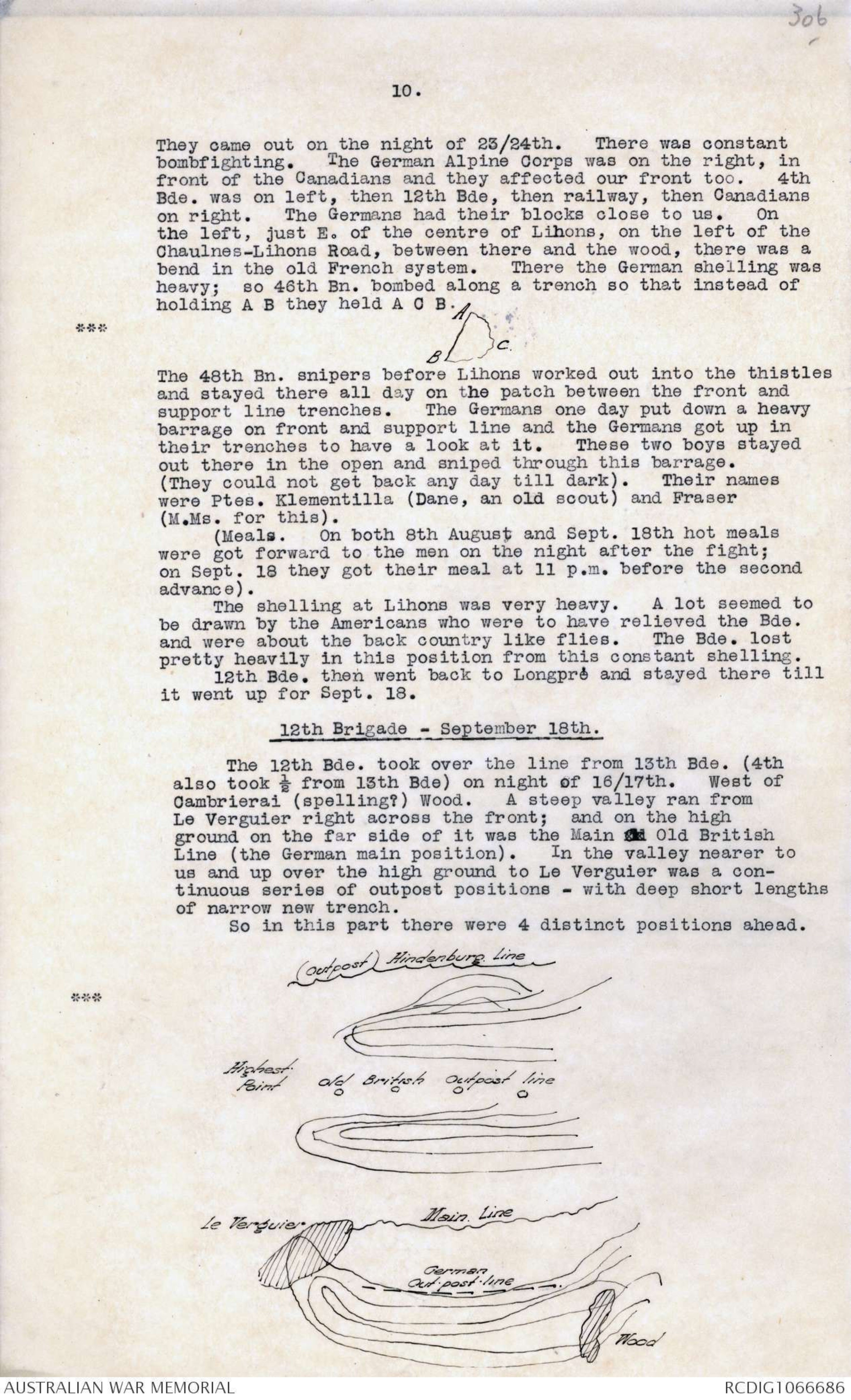
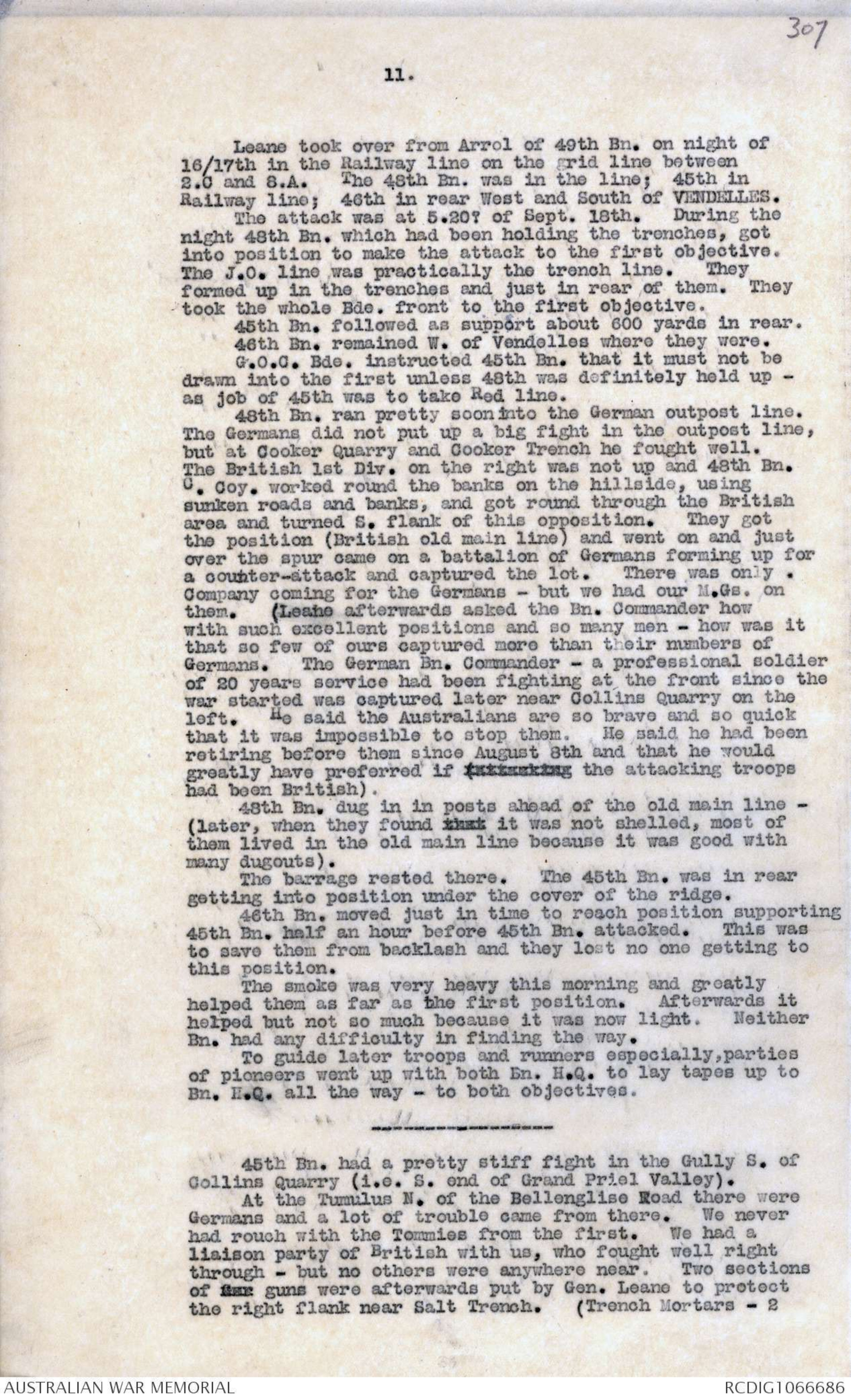
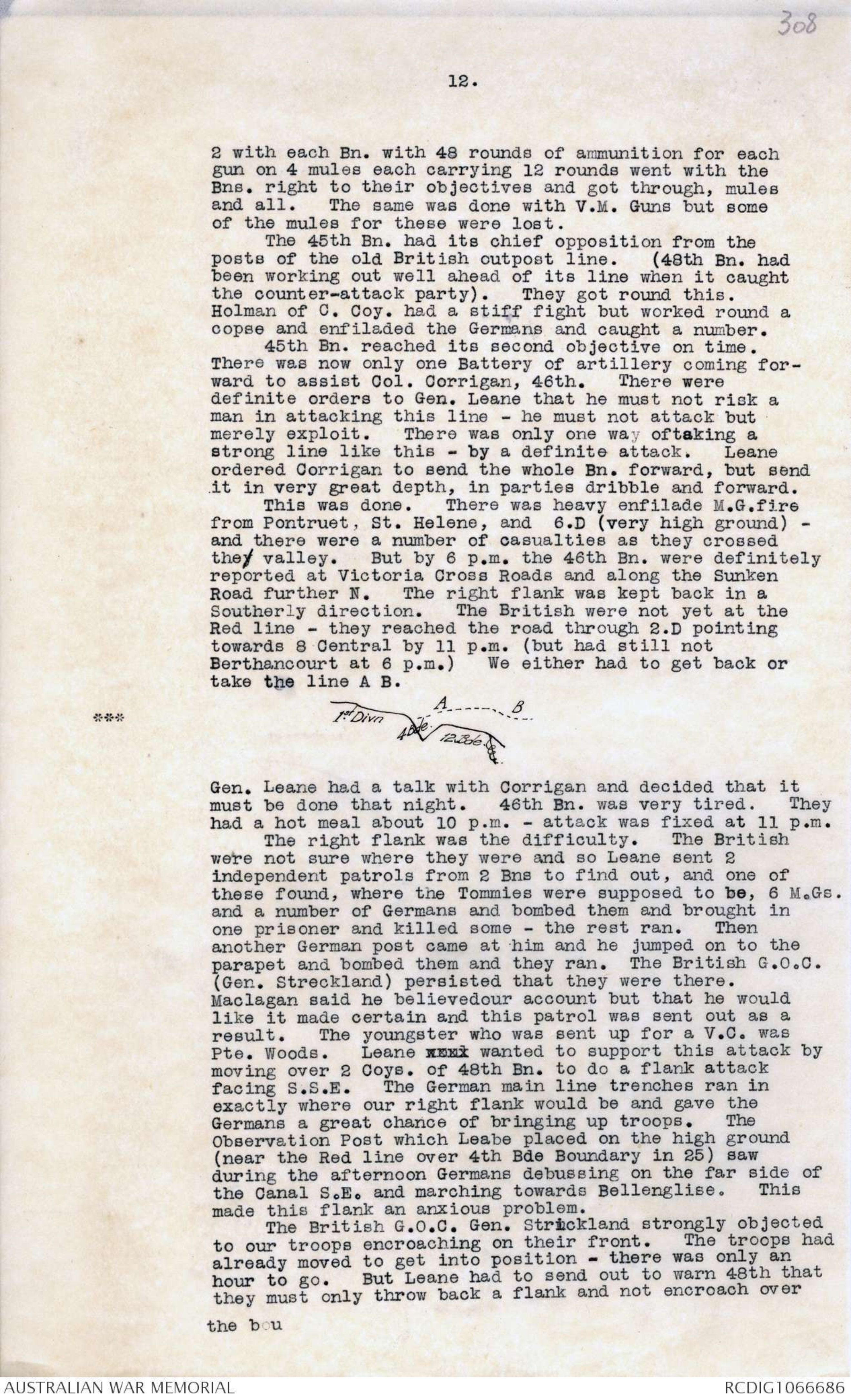
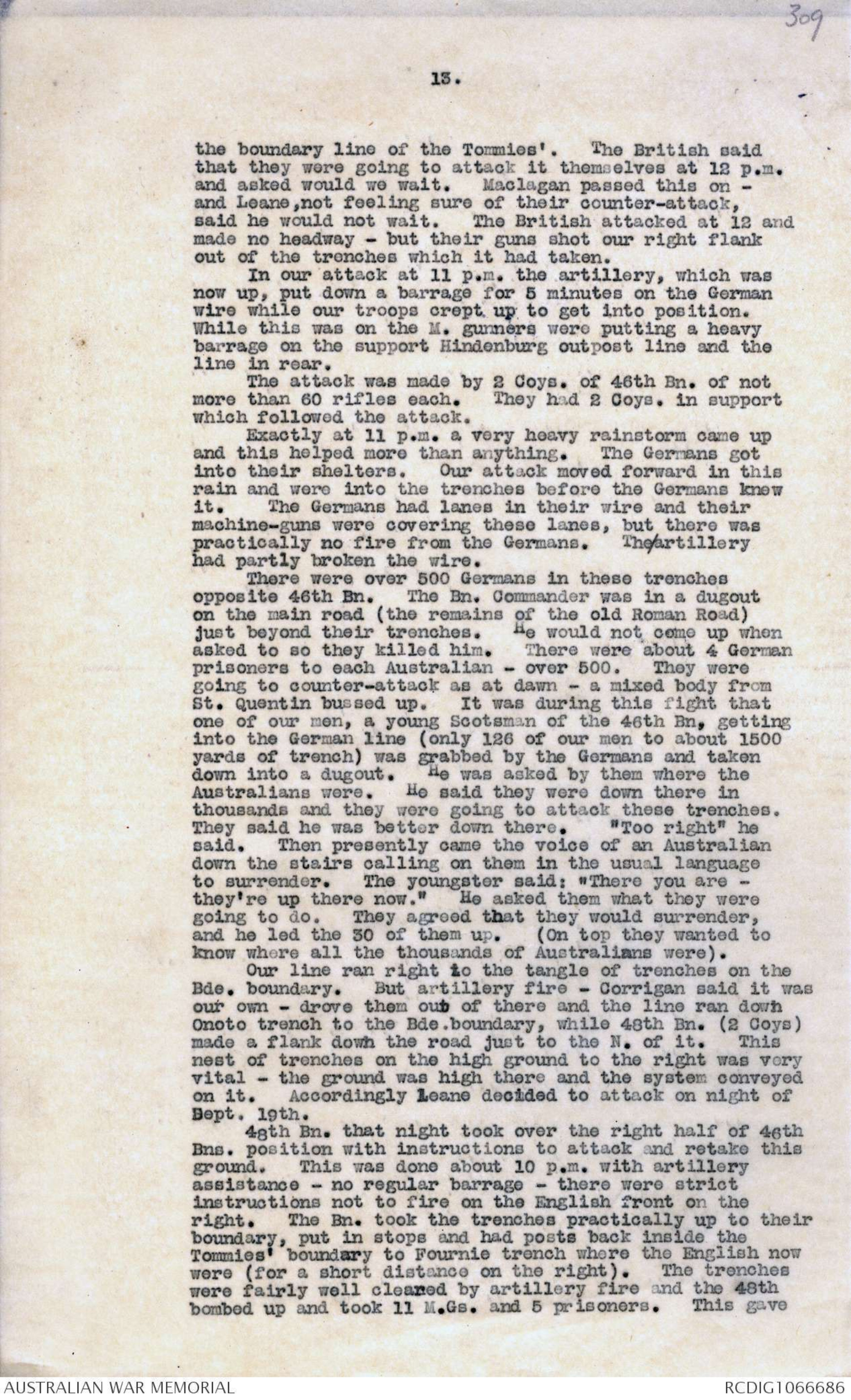
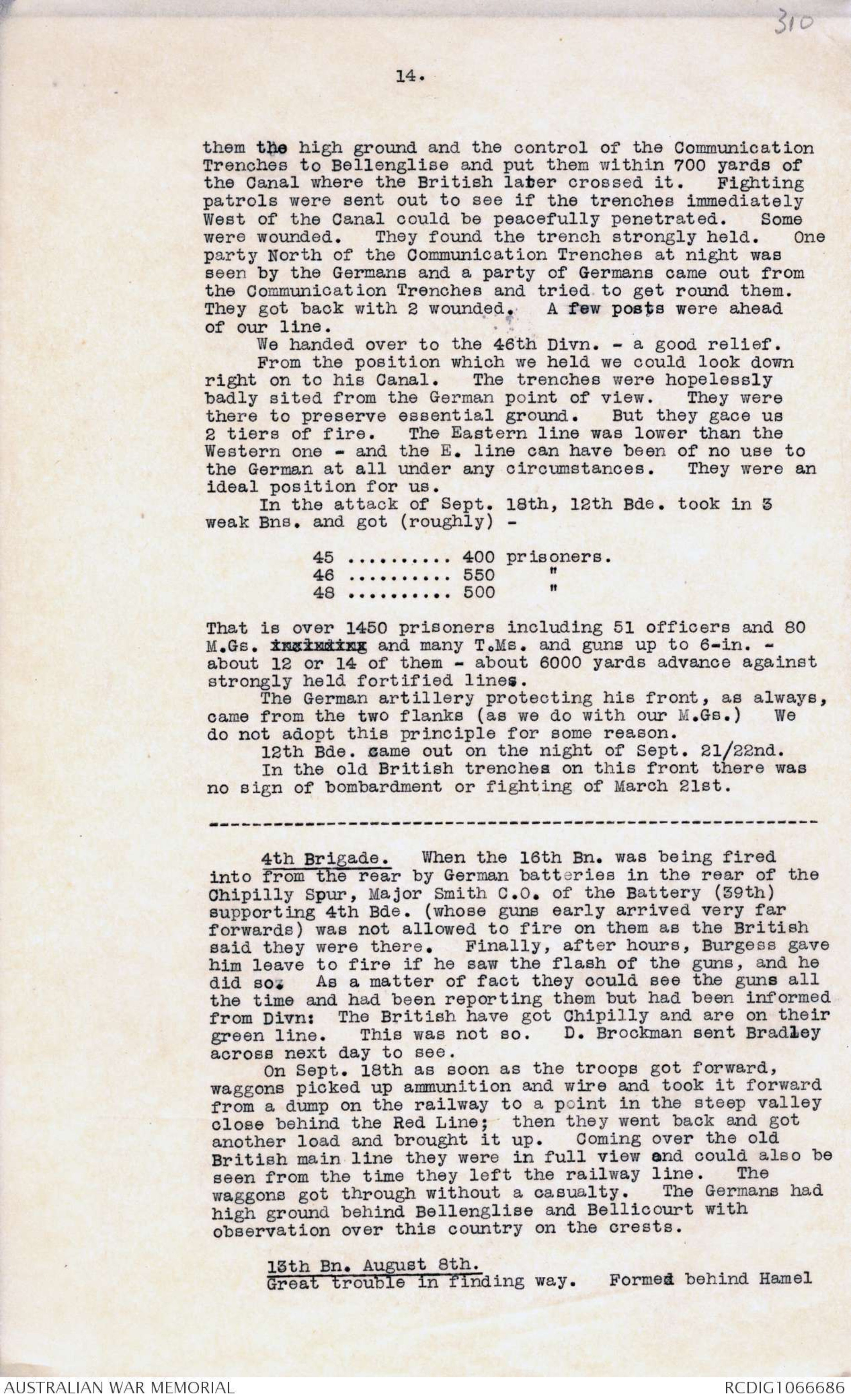
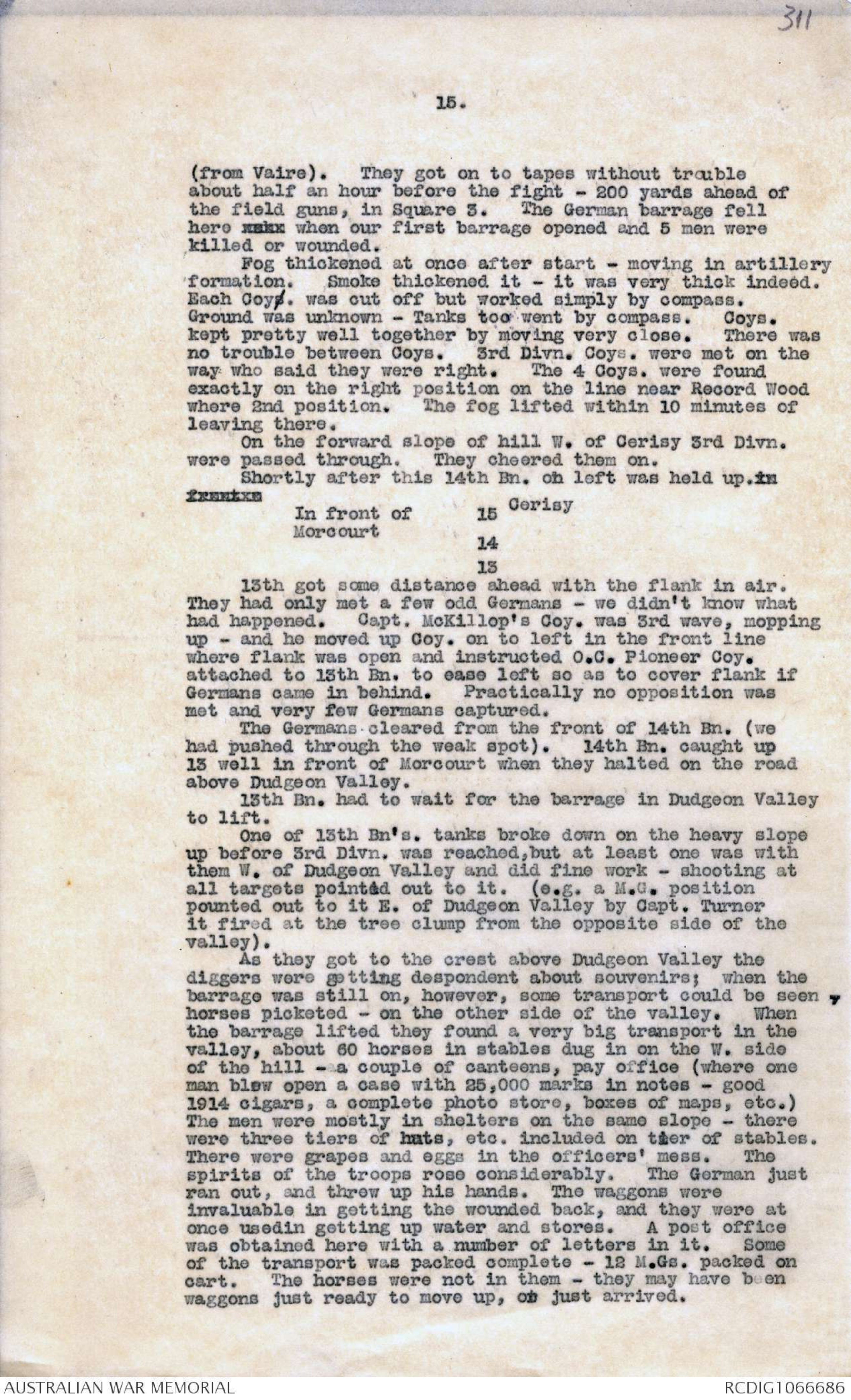
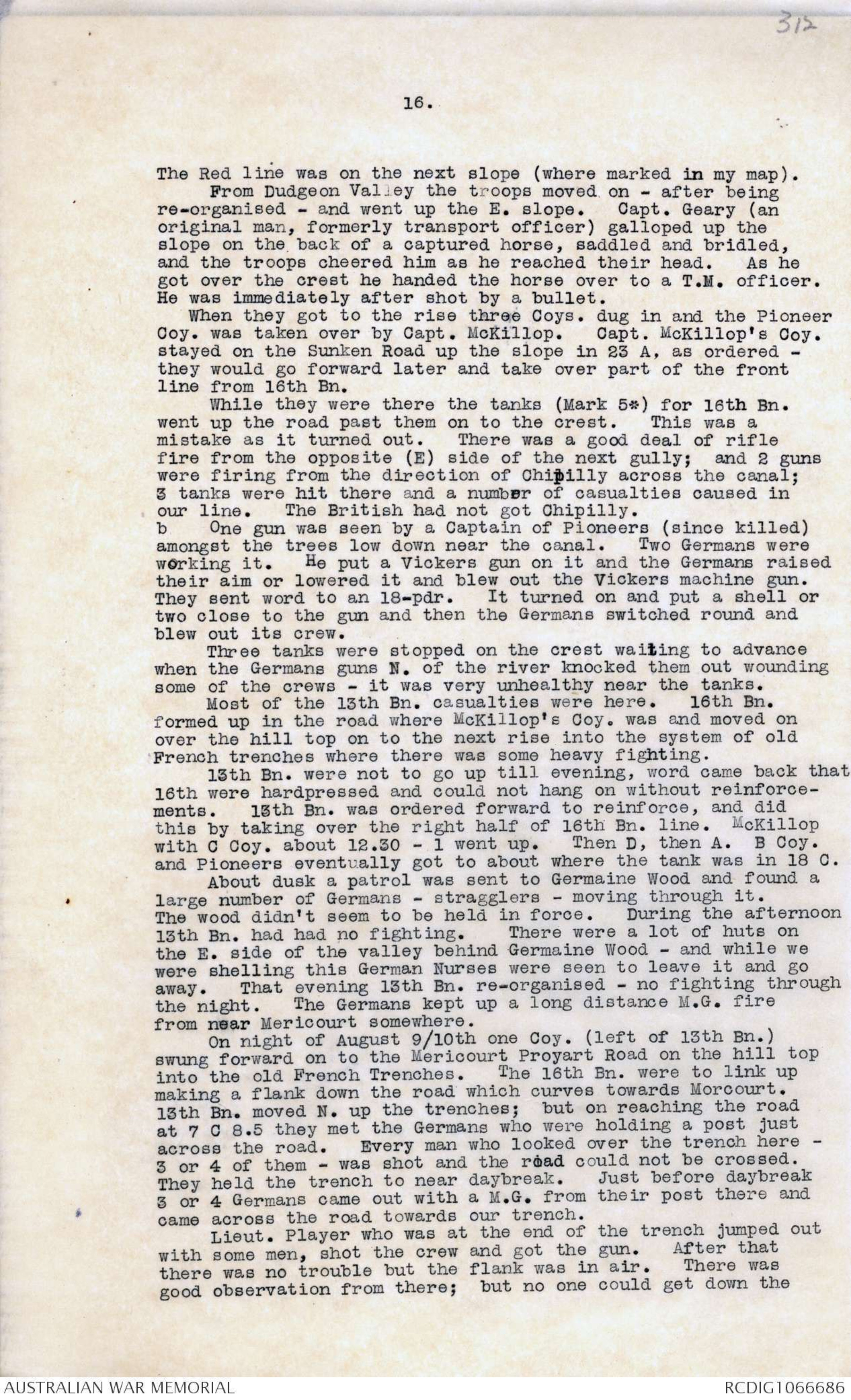
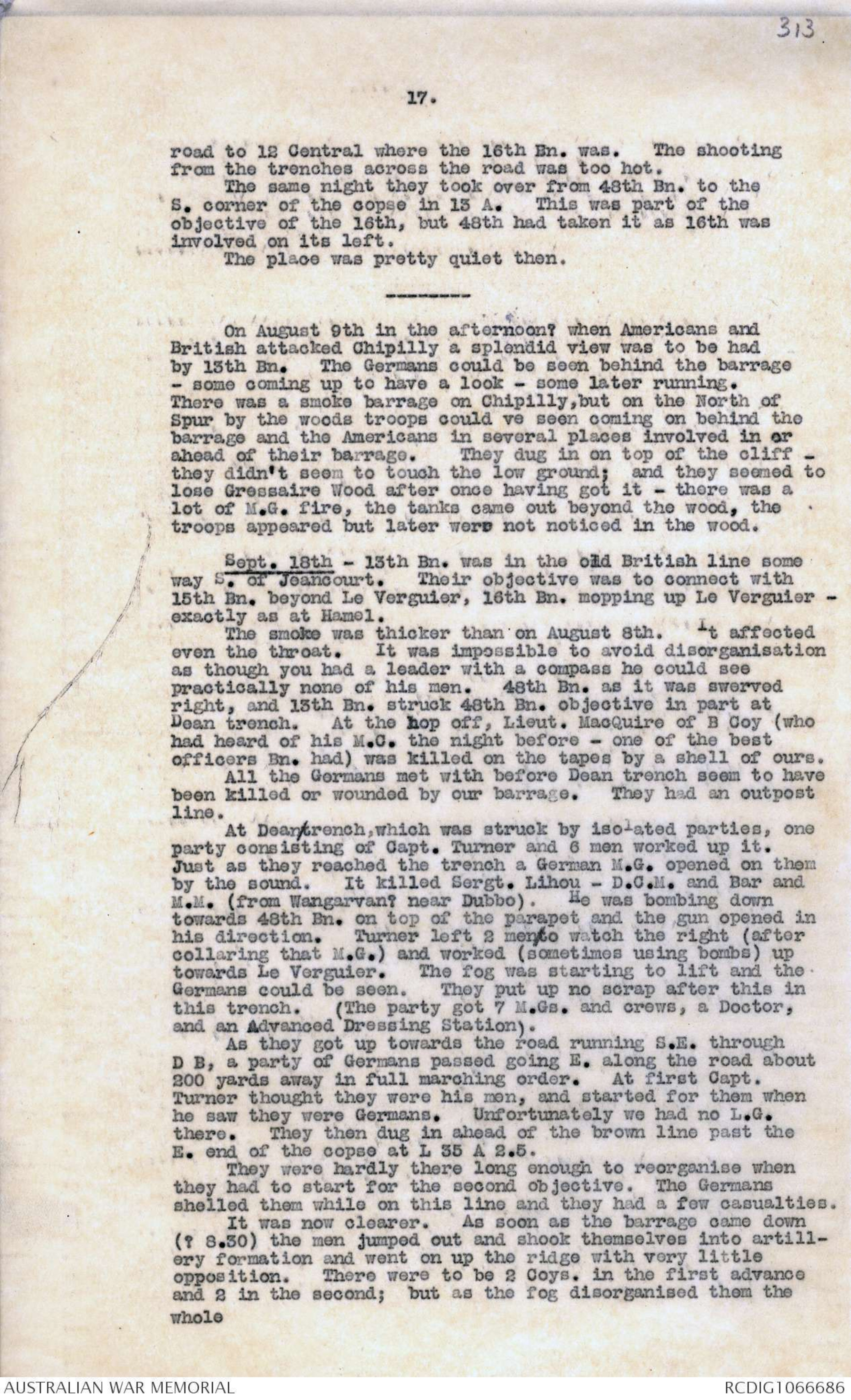
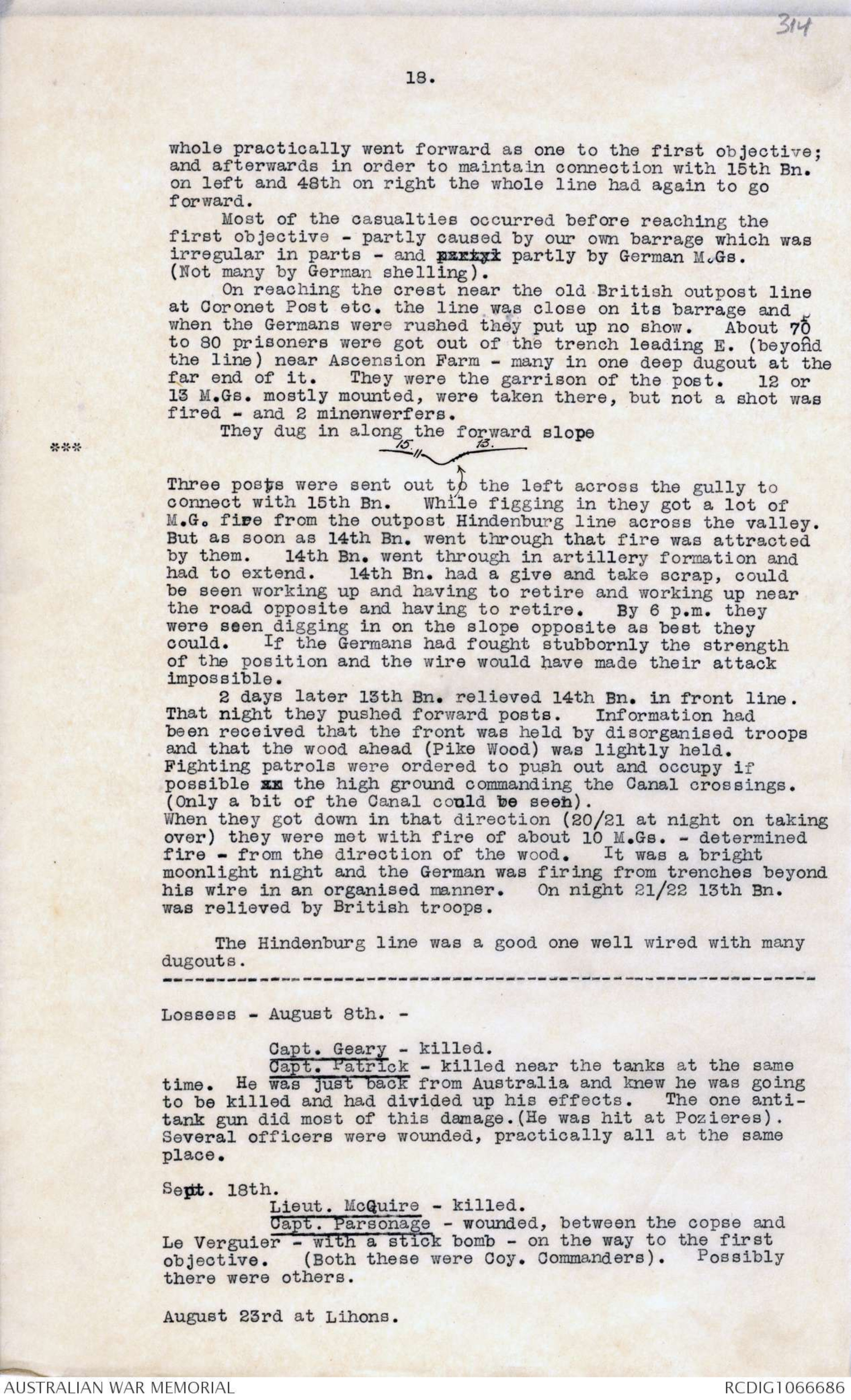
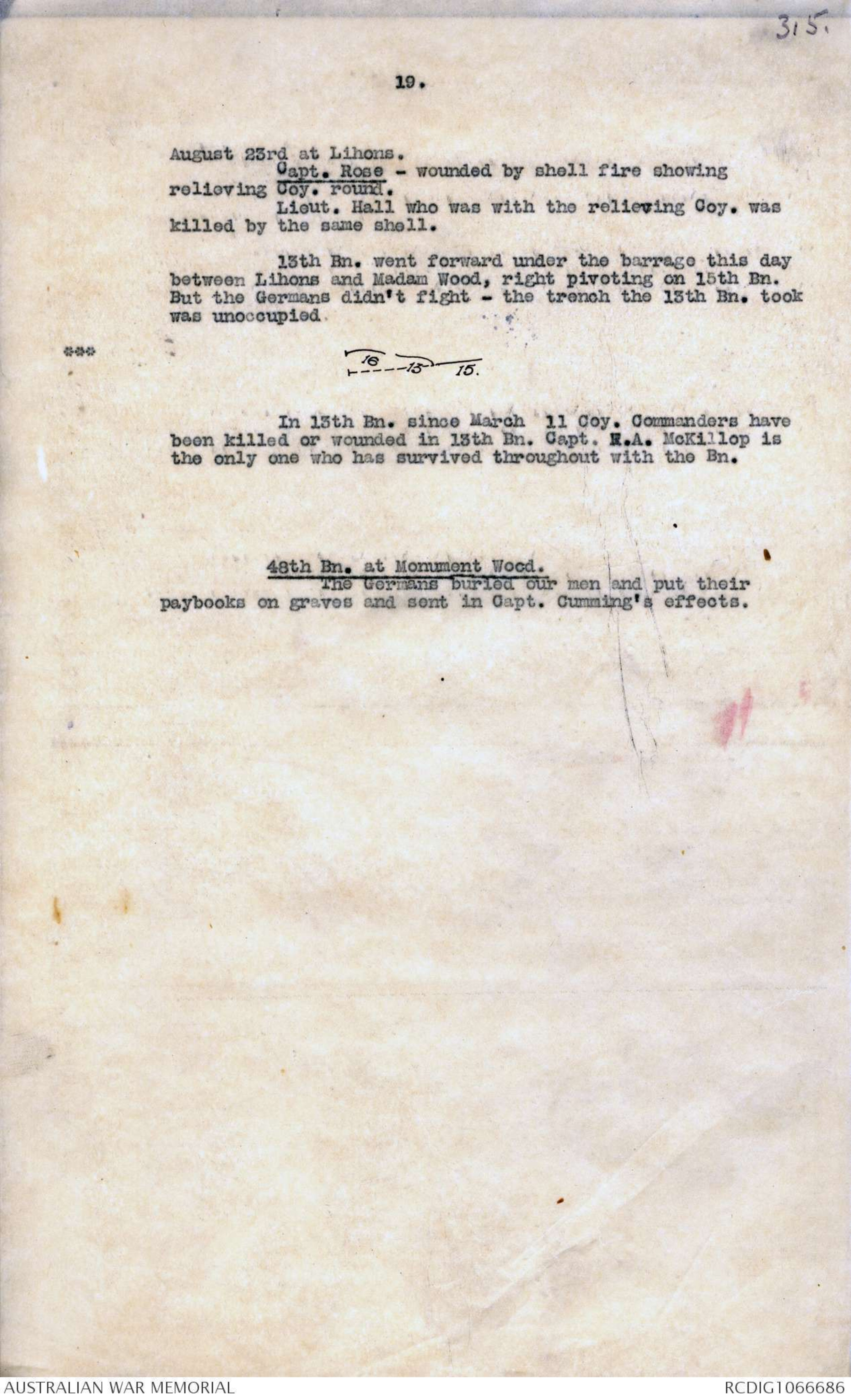
306
10.
They came out on the night of 23/24th. There was constant
bombfighting. The German Alpine Corps was on the right, in
front of the Canadians and they affected our front too. 4th
Bde. was on the left, then 12th Bde, then railway, then Canadians
on right. The Germans had their blocks close to us. On
the left, just E. of the centre of Lihons, on the left of the
Chaulnes-Lihons Road, between there and the wood, there was a
bend in the old French system. There the German shelling was
heavy; so 46th Bn. bombed along a trench so that instead of
holding A B they held A C B.
Hand drawn diagram - see original document
The 48th Bn. snipers before Lihons worked out into the thistles
and stayed there all day on the patch between the front and
support line trenches. The Germans one day put down a heavy
barrage on front and support line and the Germans got up in
their trenches to have a look at it. These two boys stayed
out there in the open and sniped through this barrage.
(They could not get back any day till dark). Their names
were Ptes. Klementilla (Dane, an old scout) and Fraser
(M.Ms. for this).
(Meals. On both 8th August and Sept. 18th hot meals
were got forward to the men on the night after the fight;
on Sept. 18 they got their meal at 11 p.m. before the second
advance).
The shelling at Lihons was very heavy. A lot seemed to
be drawn by the Americans who were to have relieved the Bde.
and were about the back country like flies. The Bde. lost
pretty heavily in this position from this constant shelling.
12th Bde. then went back to Longprē and stayed there till
it went up for Sept. 18.
12th Brigade - September 18th.
The 12th Bde. took over the line from 13th Bde. (4th
also took ½ from 13th Bde) on night of 16/17th. West of
Cambrierai (spelling?) Wood. A steep valley ran from
La Verguier right across the front; and on the high
ground on the far side of it was the Main xx Old British
Line (the German main position). In the valley nearer to
us and up over the high ground to Le Verguier was a continuous
series of outpost positions - with deep short lengths
of narrow new trench.
So in this part there were 4 distinct positions ahead.
Hand drawn diagram - see original document
307
11.
Leane took over from Arrol of 49th Bn. on night of
16/17th in the Railway line on the grid line between
2.C and 8.A. The 48th Bn. was in the line; 45th in
Railway line; 46th in rear West and South of VENDELLES.
The attack was at 5.20? of Sept. 18th. During the
night 48th Bn. which had been holding the trenches, got
into position to make the attack to the first objective.
The J.O. line was practically the trench line. They
formed up in the trenches and just in rear of them. They
took the whole Bde. front to the first objective.
45th Bn. followed as support about 600 yards in rear.
46th Bn. remained W. of Vendelles where they were.
G.O.C. Bde. instructed 45th Bn. that it must not be
drawn into the first unless 48th was definitely held up -
as job of 45th was to take Red line.
48th Bn. ran pretty soon into the German outpost line.
The Germans did not put up a big fight in the outpost line,
but at Cooker Quarry and Cooker Trench he fought well.
The British 1st Div. on the right was not up and 48th Bn.
C. Coy. worked round the banks on the hillside, using
sunken roads and banks, and got round through the British
area and turned S. flank of this opposition. They got
the position (British old main line) and went on and just
over the spur came on a battalion of Germans forming up for
a counter-attack and captured the lot. There was only .
Company coming for the Germans - but we had our M.Gs. on
them. (Leane afterwards asked the Bn. Commander how
with such excellent positions and so many men - how was it
that so few of ours captured more than their numbers of
Germans. The German Bn. Commander - a professional soldier
of 20 years service had been fighting at the front since the
war started was captured later near Collins Quarry on the
left. He said the Australians are so brave and so quick
that it was impossible to stop them. He said he had been
retiring before them since August 8th and that he would
greatly have preferred if xxxxxxxxx the attacking troops
had been British).
48th Bn. dug in in posts ahead of the old main line -
(later, when they found xxx it was not shelled, most of
them lived in the old main line because it was good with
many dugouts).
The barrage rested there. The 45th Bn. was in rear
getting into position under the cover of the ridge.
46th Bn. moved just in time to reach position supporting
45th Bn. half an hour before 45th Bn. attacked. This was
to save them from backlash and they lost no one getting to
this position.
The smoke was very heavy this morning and greatly
helped them as far as the first position. Afterwards it
helped but not so much because it was now light. Neither
Bn. had any difficulty in finding the way.
To guide later troops and runners especially, parties
of pioneers went up with both Bn. H.Q. to lay tapes up to
Bn. H.Q. all the way - to both objectives.
45th Bn. had a pretty stiff fight in the Gully S. of
Collins Quarry (i.e. S end of Grand Priel Valley).
At the Tumulus N. of the Bellenglise Road there were
Germans and a lot of trouble came from there. We never
had rouch with the Tommies from the first. We had a
liaison party of British with us, who fought well right
through- but no others were anywhere near. Two sections
of xxx guns were afterwards put by Gen. Leane to protect
the right flank near Salt Trench. (Trench Mortars - 2
308
12.
2 with each Bn. with 48 rounds of ammunition for each
gun on 4 mules each carrying 12 rounds went with the
Bns. right to their objectives and got through, mules
and all. The same was done with V.M. Guns but some
of the mules for these were lost.
The 45th Bn. had its chief opposition from the
posts of the old British outpost line. (48th Bn. had
been working out well ahead of its line when it caught
the counter-attack party). They got round this.
Holman of C. Coy had a stiff fight but worked round a
copse and enfiladed the Germans and caught a number.
45th Bn. reached its second objective on time.
There was now only one Battery of artillery coming forward
to assist Col. Corrigan, 46th. There were
definite orders to Gen. Leane that he must not risk a
man in attacking this line - he must not attack but
merely exploit. There was only one way of taking a
strong line like this - by a definite attack. Leane
ordered Corrigan to send the whole Bn. forward, but send
it in very great depth, in parties dribble and forward.
This was done. There was heavy enfilade M.G. fire
from Pontruet, St Helene, and 6.D (very high ground) -
and there were a number of casualties as they crossed
they valley. But by 6 p.m. the 46th Bn. were definitely
reported at Victoria Cross Roads and along the Sunken
Road further N. The right flank was kept back in a
Southerly direction. The British were not yet at the
Red line - they reached the road through 2.D pointing
towards 8 Central by 11 p.m. (but had still not
Berthancourt at 6 p.m.) We either had to get back or
take the line A B.
Hand drawn diagram - see original document
Gen. Leane had a talk with Corrigan and decided that it
must be done that night. 46th Bn. was very tired. They
had a hot meal about 10 p.m. - attack was fixed at 11 p.m.
The right flank was the difficulty. The British
were not sure where they were and so Leane sent 2
independent patrols from 2 Bns to find out, and one of
these found, where the Tommies were supposed to be, 6 M.Gs.
and a number of Germans and bombed them and brought in
one prisoner and killed some - the rest ran. Then
another German post came at him and he jumped on to the
parapet and bombed them and they ran. The British G.O.C.
(Gen. Streckland) persisted that they were there.
Maclagan said he believed our account but that he would
like it made certain and this patrol was sent out as a
result. The youngster who was sent up for a V.C. was
Pte. Woods. Leane xxxx wanted to support this attack by
moving over 2 Coys. of 48th Bn. to do a flank attack
facing S.S.E. The German main line trenches ran in
exactly where our right flank would be and gave the
Germans a great chance of bringing up troops. The
Observation Post which Leabe placed on the high ground
(near the Red line over 4th Bde Boundary in 25) saw
during the afternoon Germans debussing on the far side of
the Canal S.E. and marching towards Bellenglise. This
made this flank an anxious problem.
The British G.O.C Gen. Strickland strongly objected
to our troops encroaching on their front. The troops had
already moved to get into position - there was only an
hour to go. But Leane had to send out to warn 48th that
they must only throw back a flank and not encroach over the
bou
309
13.
the boundary line of the Tommies'. The British said
that they were going to attack it themselves at 12 p.m.
and asked would we wait. Maclagan passed this on -
and Leane, not feeling sure of their counter-attack,
said he would not wait. The British attacked at 12 and
made no headway - but their guns shot our right flank
out of the trenches which it had taken.
In our attack at 11 p.m. the artillery, which was
now up, put down a barrage for 5 minutes on the German
wire while our troops crept up to get into position.
While this was on the M. gunners were putting a heavy
barrage on the support Hindenburg outpost line and the
line in rear.
The attack was made by 2 Coys of 46th Bn. of not
more than 60 rifles each. They had 2 Coys. in support
which followed the attack.
Exactly at 11 p.m. a very heavy rainstorm came up
and this helped more than anything. The Germans got
into their shelters. Our attack moved forward in this
rain and were into the trenches before the Germans knew
it. The Germans had lanes in their wire and their
machine-guns were covering these lanes, but there was
practically no fire from the Germans. The artillery
had partly broken the wire.
There were over 500 Germans in these trenches
opposite 46th Bn. The Bn. Commander was in a dugout
on the main road (the remains of the old Roman Road)
just beyond their trenches. He would not come up when
asked to so they killed him. There were about 4 German
prisoners to each Australian - over 500. They were
going to counter-attack as at dawn - a mixed body from
St. Quentin bussed up. It was during this fight that
one of our men, a young Scotsman of the 46th Bn, getting
into the German line (only 126 of our men to about 1500
yards of trench) was grabbed by the Germans and taken
down into a dugout. He was asked by them where the
Australians were. He said they were down there in
thousands and they were going to attack these trenches.
They said he was better down there. "Too right" he
said. Then presently came the voice of an Australian
down the stairs calling on them in the usual language
to surrender. The youngster said: "There you are -
they're up there now." He asked them what they were
going to do. They agreed that they would surrender,
and he led the 30 of them up. (On top they wanted to
know where all the thousands of Australians were).
Our line ran right to the tangle of trenches on the
Bde. boundary. But artillery fire - Corrigan said it was
our own - drove them out of there and the line ran down
Onoto trench to the Bde. boundary, while 48th Bn. (2 Coys)
made a flank down the road just to the N. of it. This
nest of trenches on the high ground to the right was very
vital - the ground was high there and the system conveyed
on it. Accordingly Leane decided to attack on night of
Sept. 19th.
48th Bn. that night took over the right half of 46th
Bns. position with instructions to attack and retake this
ground. This was done about 10 p.m. with artillery
assistance - no regular barrage - there were strict
instructions not to fire on the English front on the
right. The Bn. took the trenches practically up to their
boundary, put in stops and had posts back inside the
Tommies' boundary to Fournie trench where the English now
were (for a short distance on the right). The trenches
were fairly well cleared by artillery fire and the 48th
bombed up and took 11 M.Gs and 5 prisoners. This gave
310
14.
them the high ground and the control of the Communication
Trenches to Bellenglise and put them within 700 yards of
the Canal where the British later crossed it. Fighting
patrols were sent out to see if the trenches immediately
West of the Canal could be peacefully penetrated. Some
were wounded. They found the trench strongly held. One
party North of the Communication Trenches at night was
seen by the Germans and a party of Germans came out from
the Communication Trenches and tried to get round them.
They got back with 2 wounded. A few posts were ahead
of our line.
We handed over to the 46th Divn. - a good relief.
From the position which we held we could look down
right on to his Canal. The trenches were hopelessly
badly sited from the German point of view. They were
there to preserve essential ground. But they gace us
2 tiers of fire. The Eastern line was lower than the
Western one - and the E. line can have been of no use to
the German at all under any circumstances. They were an
ideal position for us.
In the attack of Sept. 18th, 12th Bde. took in 3
weak Bns. and got (roughly)-
45 ......... 400 prisoners.
46 ......... 550 "
48 ......... 500 "
That is over 1450 prisoners including 51 officers and 80
M.Gs. xxxxxxx and many T.Ms. and guns up to 6-in. -
about 12 or 14 of them - about 6000 yards advance against
strongly held fortified lines.
The German artillery protecting his front, as always,
came from the two flanks (as we do with our M.Gs.) We
do not adopt this principle for some reason.
12th Bde. came out on the night of Sept. 21/22nd.
In the old British trenches on this front there was
no sign of bombardment or fighting of March 21st.
4th Brigade. When the 16th Bn. was being fired
into from the rear by German batteries in the rear of the
Chipilly Spur, Major Smith C.O. of the Battery (39th)
supporting 4th Bde. (whose guns early arrived very far
forwards) was not allowed to fire on them as the British
said they were there. Finally, after hours, Burgess gave
him leave to fire if he saw the flash of the guns, and he
did so. As a matter of fact they could see the guns all
the time and had been reporting them but had been informed
from Divn: The British have got Chipilly and are on their
green line. This was not so. D. Brockman sent Bradley
across next day to see.
On Sept. 18th as soon as the troops got forward,
waggons picked up ammunition and wire and took it forward
from a dump on the railway to a point in the steep valley
close behind the Red line; then they went back and got
another load and brought it up. Coming over the old
British main line they were in full view and could also be
seen from the time they left the railway line. The
waggons got through without a casualty. The Germans had
high ground behind Bellenglise and Bellicourt with
observation over this country on the crests.
13th Bn. August 8th.
Great trouble in finding way. Formed behind Hamel
311
15.
(from Vaire). They got on to tapes without trouble
about half an hour before the fight - 200 yards ahead of
the field guns, in Square 3. The German barrage fell
here xxxx when our first barrage opened and 5 men were
killed or wounded.
Fog thickened at once after start - moving in artillery
formation. Smoke thickened it - it was very thick indeed.
Each Coys. was cut off but worked simply by compass.
Ground was unknown - Tanks too went by compass. Coys.
kept pretty well together by moving very close. There was
no trouble between Coys. 3rd Divn. Coys. were met on the
way who said they were right. The 4 Coys. were found
exactly on the right position on the line near Record Wood
where 2nd position. The fog lifted within 10 minutes of
leaving there.
On the forward slope of hill W. of Cerisy 3rd Divn.
were passed through. They cheered them on.
Shortly after this 14th Bn. on left was held up.xxxxxxxxx
Cerisy
In front of 15
Morcourt 14
13
13th got some distance ahead with the flank in air.
They had only met a few odd Germans - we didn't know what
had happened. Capt. McKillop's Coy. was 3rd wave, mopping
up - and he moved up Coy. on to left in the front line
where flank was open and instructed O.C. Pioneer Coy.
attached to 13th Bn. to ease left so as to cover flank if
Germans came in behind. Practically no opposition was
met and very few Germans captured.
The Germans cleared from the front of 14th Bn. (we
had pushed through the weak spot). 14th Bn. caught up
13 well in front of Morcourt when they halted on the road
above Dudgeon Valley
13th Bn. had to wait for the barrage in Dudgeon Valley
to lift.
One of 13th Bn's. tanks broke down on the heavy slope
up before 3rd Divn. was reached, but at least one was with
them W. of Dudgeon Valley and did fine work - shooting at
all targets pointed out to it. (e.g. a M.G. position
pounted out to it E. of Dudgeon Valley by Capt. Turner
it fired at the tree clump from the opposite side of the
valley).
As they got to the crest above Dudgeon Valley the
diggers were getting despondent about souvenirs; when the
barrage was still on, however, some transport could be seen-
horses picketed - on the other side of the valley. When
the barrage lifted they found a very big transport in the
valley, about 60 horses in stables dug in on the W. side
of the hill - a couple of canteens, pay office (where one
man blew open a case with 25,000 marks in notes - good
1914 cigars, a complete photo store, boxes of maps, etc.)
The men were mostly in shelters on the same slope - there
were three tiers of huts, etc. included on tier of stables.
There were grapes and eggs in the officers' mess. The
spirits of the troops rose considerably. The German just
ran out, and threw up his hands. The waggons were
invaluable in getting the wounded back, and they were at
once used in getting up water and stores. A post office
was obtained here with a number of letters in it. Some
of the transport was packed complete - 12 M.Gs. packed on
cart. The horses were not in them - they may have been
waggons just ready to move up, or just arrived.
312
16.
The Redline was on the next slope (where marked in my map).
From Dudgeon Valley the troops moved on - after being
re-organised - and went up the E. slope. Capt. Geary (an
original man, formerly transport officer) galloped up the
slope on the back of a captured horse, saddled and bridled,
and the troops cheered him as he reached their head. As he
got over the crest he handed the horse over to a T.M. officer.
He was immediately after shot by a bullet.
When they got to the rise three Coys. dug in and the Pioneer
Coy. was taken over by Capt. McKillop. Capt. McKillop's Coy.
stayed on the Sunken Road up the slope in 23 A. as ordered-
they would go forward later and take over part of the front
line from 16th Bn.
While they were there the tanks (Mark 5*) for 16th Bn.
went up the road past them on to the crest. This was a
mistake as it turned out. There was a good deal of rifle
fire from the opposite (E) side of the next gully; and 2 guns
were firing from the direction of Chipilly across the canal;
3 tanks were hit there and a number of casualties caused in
our line. The British had not got Chipilly.
b One gun was seen by a Captain of Pioneers (since killed)
amongst the trees low down near the canal. Two Germans were
working it. He put a Vickers gun on it and the Germans raised
their aim or lowered it and blew out the Vickers machine gun.
They sent word to an 18-pdr. It turned on and put a shell or
two close to the gun and then the Germans switched round and
blew out its crew.
Three tanks were stopped on the crest waiting to advance
when the Germans guns N. of the river knocked them out wounding
some of the crews - it was very unhealthy near the tanks.
Most of the 13th Bn. casualties were here. 16th Bn.
formed up in the road where McKillop's Coy. was and moved on
over the hill top on to the next rise into the system of old
French trenches where there was some heavy fighting.
13th Bn. were not to go up till evening, word came back that
16th were hardpressed and could not hang on without reinforcements.
13th Bn. was ordered forward to reinforce, and did
this by taking over the right half of 16th Bn. line. McKillop
with C Coy. about 12.30 - 1 went up. Then D, then A. B Coy.
and Pioneers eventually got to about where the tank was in 18 C.
About dusk a patrol was sent to Germaine Wood and found a
large number of Germans - stragglers - moving through it.
The wood didn't seem to be held in force. During the afternoon
13th Bn. had no fighting. There were a lot of huts of
the E. side of the valley behind Germaine Wood - and while we
were shelling this German Nurses were seen to leave it and go
away. That evening 13th Bn. re-organised - no fighting through
the night. The Germans kept up a long distance M.G. fire
from near Mericourt somewhere.
On night of August 9/10th one Coy. (left of 13th Bn.)
swung forward on to the Mericourt Proyart Road on the hill top
into the old French Trenches. The 16th Bn. were to link up
making a flank down the road which curves towards Morcourt.
13th Bn. moved N. up the trenches; but on reaching the road
at 7 C 8.5 they met the Germans who were holding a post just
across the road. Every man who looked over the trench here -
3 or 4 or them - was shot and the road could not be crossed.
They held the trench to near daybreak. Just before daybreak
3 or 4 Germans came out with a M.G. from their post there and
came across the road towards our trench.
Lieut. Player who was at the end of the trench jumped out
with some men, shot the crew and got the gun. After that
there was no trouble but the flank was in air. There was
good observation from there; but no one could get down the
313.
17.
road to 12 Central where the 16th Bn. was. The shooting
from the trenches across the road was too hot.
The same night they took over from 48th Bn. to the
S. corner of the copse in 13 A. This was part of the
objective of the 16th, but 48th had taken it as 16th was
involved on its left.
The place was pretty quiet then.
On August 9th in the afternoon? when Americans and
British attacked Chipilly a splendid view was to be had
by 13th Bn. The Germans could be seen behind the barrage
- some coming up to have a look - some later running.
There was a smoke barrage on Chipilly, but on the North of
Spur by the woods troops could ve seen coming on behind the
barrage and the Americans in several places involved in or
ahead of their barrage. They dug in on top of the cliff -
they didn't seem to touch the low ground; and they seemed to
lose Gressaire Wood after once having got it - there was a
lot of M.G. fire, the tanks came out beyond the wood, the
troops appeared but later were not noticed in the wood.
Sept. 18th - 13th Bn. was in the old British line some
way S. of Jeancourt. Their objective was to connect with
15th Bn. beyond Le Verguier, 16th Bn. mopping up Le Verguier -
exactly as at Hamel.
The smoke was thicker than on August 8th. It affected
even the throat. It was impossible to avoid disorganisation
as though you had a leader with a compass he could see
practically none of his men. 48th Bn. as it was swerved
right, and 13th Bn. struck 48th Bn. objective in part at
Dean trench. At the hop off, Lieut. MacQuire of B Coy (who
had heard of his M.C. the night before - one of the best
officers Bn. had) was killed on the tapes by a shell of ours.
All the Germans met with before Dean trench seem to have
been killed or wounded by our barrage. They had an outpost
line.
At Dean trench, which was struck by isolated parties, one
party consisting of Capt. Turner and 6 men worked up it.
Just as they reached the trench a German M.G. opened on them
by the sound. It killed Sergt. Lihou - D.C.M. and Bar and
M.M. (from Wangarvan? near Dubbo). He was bombing down
towards 48th Bn. on top of the parapet and the gun opened in
his direction. Turner left 2 men to watch the right (after
collaring that M.G.) and worked (sometimes using bombs) up
towards Le Verguier. The fog was starting to lift and the
Germans could be seen. They put up no scrap after this in
this trench. (The party got 7 M.Gs. and crews, a Doctor,
and an Advanced Dressing Station).
As they got up towards the road running S.E. through
D B, a party of Germans passed going E. along the road about
200 yards away in full marching order. At first Capt.
Turner thought they were his men, and started for them when
he saw they were Germans. Unfortunately we had no L.G.
there. They then dug in ahead of the brown line past the
E. end of the copse at L 35 A 2.5.
They were hardly there long enough to reorganise when
they had to start for the second objective. The Germans
shelled them while on this line and they had a few casualties.
It was now clearer. As soon as the barrage came down
(? 8.30) the men jumped out and shook themselves into artillery
formation and went on up the ridge with very little
opposition. There were to be 2 Coys. in the first advance
and 2 in the second; but as the fog disorganised them the
whole
314
18.
whole practically went forward as one to the first objective;
and afterwards in order to maintain connection with the 15th Bn.
on left and 48th on right the whole line had again to go
forward.
Most of the casualties occurred before reaching the
first objective - partly caused by our own barrage which was
irregular in parts - and xxxxx partly by German M.Gs.
(Not many by German shelling).
On reaching the crest near the old British outpost line
at Coronet Post etc. the line was close on its barrage and
when the Germans were rushed they put up no show. About 70
to 80 prisoners were got out of the trench leading E. (beyond
the line) near Ascension Farm - many in one deep dugout at the
far end of it. They were the garrison of the post. 12 or
13 M.Gs. mostly mounted, were taken there, but not a shot was
fired - and 2 minenwerfers.
They dug in along the forward slope
Hand drawn diagram - see original document
Three posts were sent out to the left across the gully to
connect with 15th Bn. While figging in they got a lot of
M.G. fire from the outpost Hindenburg line across the valley.
But as soon as 14th Bn. went through that fire was attracted
by them. 14th Bn. went through in artillery formation and
had to extend. 14th Bn. had a give and take scrap, could
be seen working up and having to retire and working up near
the road opposite and having to retire. By 6 p.m. they
were seen digging in on the slope opposite as best they
could. If the Germans had fought stubbornly the strength
of the position and the wire would have made their attack
impossible.
2 days later 13th Bn. relieved 14th Bn. in front line.
That night they pushed forward posts. Information had
been received that the front was held by disorganised troops
and that the wood ahead (Pike Wood) was lightly held.
Fighting patrols were ordered to push out and occupy if
possible xx the high ground commanding the Canal crossings.
(Only a bit of the Canal could be seen).
When they got down in that direction (20/21 at night on taking
over) they were met with fire of about 10 M.Gs. - determined
fire - from the direction of the wood. It was a bright
moonlight night and the German was firing from trenches beyond
his wire in an organised manner. On night 21/22 13th Bn.
was relieved by British troops.
The Hindenburg line was a good one well wired with many
dugouts.
Lossess - August 8th. -
Capt. Geary - killed.
Capt. Patrick - killed near the tanks at the same
time. He was just back from Australia and knew he was going
to be killed and had divided up his effects. The one anti-tank
gun did most of this damage. (He was hit at Pozieres).
Several officers were wounded, practically all the same
place.
Sept. 18th.
Lieut. McGuire - killed.
Capt. Parsonage - wounded, between the copse and
Le Verguier - with a stick bomb - on the way to the first
objective. (Both these were Coy. Commanders). Possibly
there were others.
August 23rd at Lihons.
315.
19.
August 23rd at Lihons.
Capt. Rose - wounded by shell fire showing
relieving Coy. round.
Lieut. Hall who was with the relieving Coy. was
killed by the same shell.
13th Bn. went forward under the barrage this day
between Lihons and Madam Wood, right pivoting on the 15th Bn.
But the Germans didn't fight - the trench the 13th Bn. took
was unoccupied.
Hand drawn diagram - see original document
In 13th Bn. since March 11 Coy. Commanders have
been killed or wounded in 13th Bn. Capt. R.A. McKillop is
the only one who has survived throughout with the Bn.
48th Bn. at Monument Wood.
The Germans buried our men and put their
paybooks on graves and sent in Capt. Cumming's effects.
 Maralyn K
Maralyn KThis transcription item is now locked to you for editing. To release the lock either Save your changes or Cancel.
This lock will be automatically released after 60 minutes of inactivity.